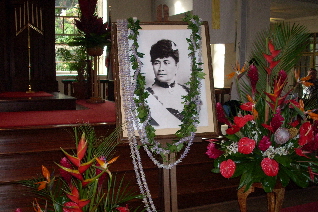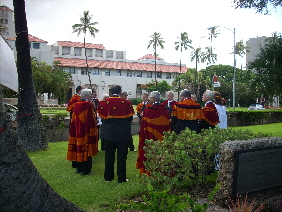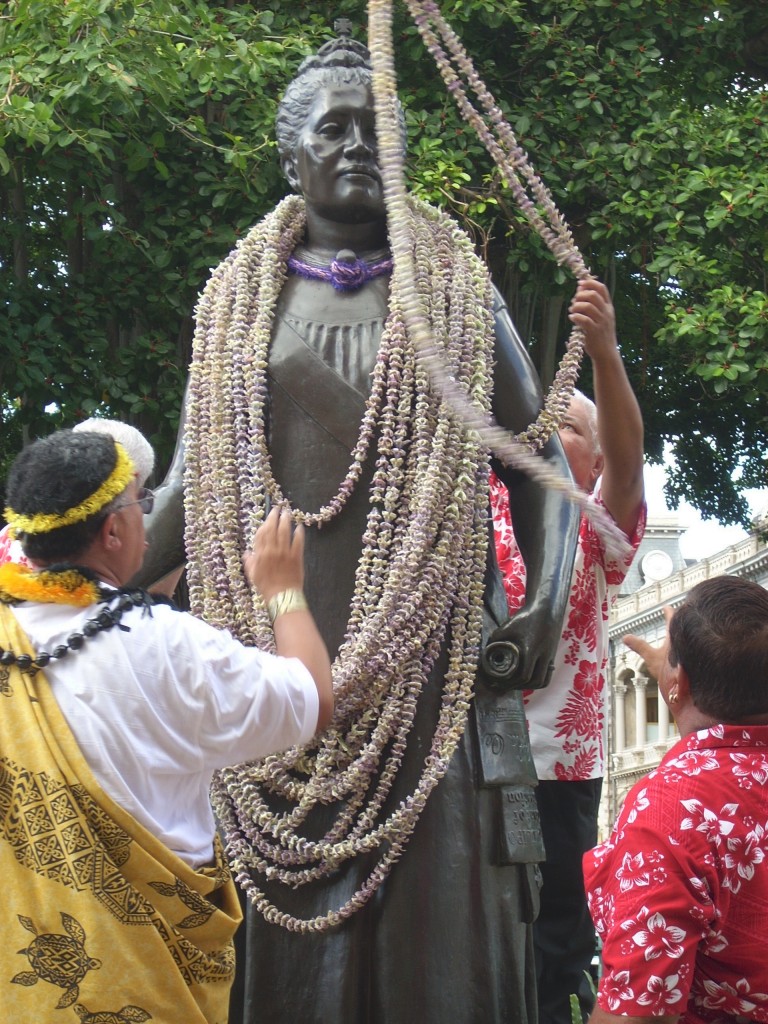The Queen’s Prayer
The last queen of Hawai‘i’s best known composition is Aloha Oe, which is heard in the soundtrack of everything from Elvis Presley’s “Blue Hawaii” to the Disney movie “Lilo and Stitch.” But the one that brought tears to my eyes this morning was “The Queen’s Prayer,” a hymn she wrote when she was imprisoned for eight months following a failed insurrection against the 1893 overthrow of the independent kingdom of Hawai‘i.
Every Sunday, congregants at Honolulu’s Westminster Cathedral, the Kawaiaha‘o Church, sing this hymn, known as Ke Aloha O Ka Haku, in alternating verses of Hawaiian and English. It is a reminder of the last Hawaiian monarch’s faith and her ability to forgive her enemies. During the year, the church holds a few “Ali‘i” services to remember the Kingdom of Hawaii’s high chiefs, usually on the Sundays before their birthdays.
Today was the “Ali‘i Sunday” dedicated to Queen Lili‘uokalani, who was born on September 2. She was born in 1838, the same year that the Cherokees were forcibly relocated from their homelands to Indian Territory along the Trail of Tears, and she died in 1917, long after Hawaii had been annexed to the United States. But she remains deeply alive to Hawaiians. So I decided to learn more about how some Hawaiians feel about their last queen at today’s service.
By eight in the morning, even though it was drizzling in downtown Honolulu, the front doors to the church as well as the side doors were flung wide open, allowing the trade winds that had kept Honolulu cool in recent days flow through. Members of the Royal Hawaiian Societies gathered on the lawn near the steps, some men wearing red and yellow capes, a group of women dressed entirely in ankle-length black gowns, most with black gloves and hats as well – brightened only by the orange lei they wore around their necks.
Another group wore all white versions of the holoku, the modest, full-length gown introduced by the missionaries, shortly after their arrival in 1820. More than a hundred children and family members who’ve benefited from the Queen’s financial legacy – the Lili‘uokalani Trust and the Children’s Center it helps fund – also attended.
Near the altar stood a stood a framed black and white photo of the Queen as a young woman, her image slightly faded with time yet brightened by the dozen or so flower garlands surrounding it. The photographer captured her at a moment when she seemed to be gazing thoughtfully at something off to the side.
After the service, which some people celebrated barefoot in the more relaxed Hawaiian style, I had a chance to meet the Lili‘uokalani Trust’s Chairman, Thomas Ka’auwai Kaulukukui, Jr., Trustee Claire Asam, and Ben Henderson, who is President and Executive Director of the Children’s Center.
Walking over together to the statue of the Queen that stands with her back to ‘Iolani Palace and faces Hawai‘i’s modern legislature building. Like all Hawaiians, the deposed queen became a U.S. citizen when Hawai‘i became a U.S. Territory in 1900.
I asked Thomas Kaulukukui why he felt the queen was able to forgive her enemies, considering that – as the Kahu (or Rev.) Teruo Kawata in his sermon put it, they’d “dethroned her and took away her nation…” but, even so, “The queen called on her people to forgive.”
He replied that he felt she was a deeply Christian woman who was also a realist – time had moved on, and though she continued to try to win back her nation even after the overthrow, she also did not allow herself to become bitter or to give up. In the same spirit of aloha, he handed me a delicate lavender-colored lei, made of the crown flowers that the Queen loved so much, so that I could join the ceremony to honor her, as a member of one of Hawaii’s civic societies took it from me and gently draped the garland of flowers over her outstretched hand.


